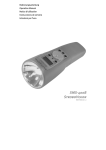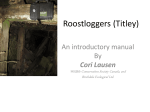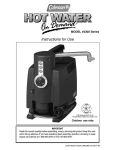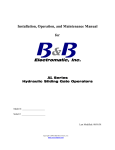Download DT-900 manual spreads - Reliability Direct, Inc.
Transcript
NOTES CONTENTS ..................................................... Page 01.0 Introduction . . . . . . . . . . . . . . . . . . . . . . . . . . . . . . . . . . . . . . . . . . . . . . . . . 1.1 Complete kit 02 02.0 Overview . . . . . . . . . . . . . . . . . . . . . . . . . . . . . . . . . . . . . . . . . . . . . . . . 2.1 Mounting stroboscope 2.2 Display Messages 03 03.0 Measuring RPM . . . . . . . . . . . . . . . . . . . . . . . . . . . . . . . . . . . . . . . . . . 3.1 Measuring true revolutions per minute (RPM) 3.2 Internal triggering mode 3.3 External triggering mode 3.4 Adjusting flash rate 3.5 Phase shift function 05 04.0 Tachometer Mode . . . . . . . . . . . . . . . . . . . . . . . . . . . . . . . . . . . . . . . . . . . . . 08 05.0 Flash tube replacement . . . . . . . . . . . . . . . . . . . . . . . . . . . . . . . . . . . . . . . 09 06.0 Charging the battery . . . . . . . . . . . . . . . . . . . . . . . . . . . . . . . . . . . . . . . . . . 11 07.0 Troubleshooting . . . . . . . . . . . . . . . . . . . . . . . . . . . . . . . . . . . . . . . . . . . . . . 12 08.0 Specifications . . . . . . . . . . . . . . . . . . . . . . . . . . . . . . . . . . . . . . . . . . . . . . . . 13 09.0 Appendix . . . . . . . . . . . . . . . . . . . . . . . . . . . . . . . . . . . . . . . . . . . . . . . . . . . . . 14 10.0 Warranty . . . . . . . . . . . . . . . . . . . . . . . . . . . . . . . . . . . . . . . . . . . . . . . . . . . . . 15 Direct view of the lamp may trigger an epileptic seizure. Eye damage may result from improper use of the lamp. WARNING 16 1 1.0 INTRODUCTION 10.0 WARRANTY Stroboscopes are used in various applications, such as quality machine inspection and timing. At high speed or high frequency operation the human eye cannot discern a single image of a moving object. Stroboscopes freeze these images by matching the speed of the moving object with short duration flashes. An indicator or reference point, such as a small tape or paint mark can be visually rotated in any direction depending on the phase angle and flash rate it is subjected to. The Electromatic DT-900 stroboscope has many of the same capabilities as our DT-300 and DT-700 series stroboscopes, but is smaller. 1.1 Complete Kit The DT-900 is supplied as a complete kit including: • • • • DT-900 gauge Charger Spare lamp Operating instructions Additional parts such as sensors, holster and spare battery pack are sold separately (see accessories on page 13). An optional carrying case is also available. Please check with your dealer for more information. Carrying Case (optional) Strobe ELECTROMATIC Equipment Co., Inc. (ELECTROMATIC) warrants to the original purchaser that this product is of merchantable quality and confirms in kind and quality with the descriptions and specifications thereof. Product failure or malfunction arising out of any defect in workmanship or material in the product existing at the time of delivery thereof which manifests itself within one year from the sale of such product, shall be remedied by repair or replacement of such product, at ELECTROMATIC’s option, except where unauthorized repair, disassembly, tampering, abuse or misapplication has taken place, as determined by ELECTROMATIC. All returns for warranty or non-warranty repairs and/or replacement must be authorized by ELECTROMATIC, in advance, with all repacking and shipping expenses to the address below to be borne by the purchaser. THE FOREGOING WARRANTY IS IN LIEU OF ALL OTHER WARRANTIES, EXPRESSED OR IMPLIED, INCLUDING BUT NOT LIMITED TO, THE WARRANTY OF MERCHANTABILITY AND FITNESS FOR ANY PARTICULAR PURPOSE OR APPLICATION. ELECTROMATIC SHALL NOT BE RESPONSIBLE NOR LIABLE FOR ANY CONSEQUENTIAL DAMAGE, OF ANY KIND OR NATURE, RESULTING FROM THE USE OF SUPPLIED EQUIPMENT, WHETHER SUCH DAMAGE OCCURS OR IS DISCOVERED BEFORE, UPON OR AFTER REPLACEMENT OR REPAIR, AND WHETHER OR NOT SUCH DAMAGE IS CAUSED BY MANUFACTURER’S OR SUPPLIER’S NEGLIGENCE WITHIN ONE YEAR FROM INVOICE DATE. Some State jurisdictions or States do not allow the exclusion or limitation of incidental or consequential damages, so the above limitation may not apply to you. The duration of any implied warranty, including, without limitation, fitness for any particular purpose and merchantability with respect to this product, is limited to the duration of the foregoing warranty. Some states do not allow limitations on how long an implied warranty lasts but, not withstanding, this warranty, in the absence of such limitations, shall extend for one year from the date of invoice. ELECTROMATIC Equipment Co., Inc. 600 Oakland Ave. Cedarhurst, NY 11516—USA Tel: 1-800-645-4330/ Tel: 516-295-4300/ Fax: 516-295-4399 Battery Pack Every precaution has been taken in the preparation of this manual. Electromatic Equipment Co., Inc., assumes no responsibility for errors or omissions. Neither is any liability assumed for damages resulting from the use of information contained herein. Any brand or product names mentioned herein are used for identification purposes only, and are trademarks or registered trademarks of their respective holders. 2 15 9.0 APPENDIX - DIMENSIONS 2.0 OVERVIEW DT-900 dimensions with battery pack. Dimensions are in inches. AC Adapter Charger Connection Power Button Flash rate divided by 2 Adjustment Dial Mode Control Flash Rate multiplied by 2 Power Indicator Rechargeable Battery Pack Easy tab for Battery Pack removal External Triggering Connector Battery pack. Dimensions are in inches Phase control 2.1 Mounting Stroboscope To mount the strobe on a tripod (or any other mounting surface), use a 1/4-20unc screw, 8mm long or shorter. Insert the screw into the mounting screw hole (see photo below) and tighten. Stroboscope Battery Pack Mounting Screw Hole 1/4 x 20 unc 14 3 8.0 SPECIFICATIONS 2.2 Display Messages Low Battery Indicator will appear when the battery needs recharging. Although the stroboscope will continue to flash, it is recommended that you charge the battery when this message appears. External Mode. When switched to External Mode Triggering (see page 6), the DT-900 automatically looks for an external signal source. If a signal is detected, the LED power indicator turns green. If no signal is detected, the LED will turn red, and the message no input appears. Tachometer Mode. When switched to Tachometer Mode (see page 8), the DT-900 automatically looks for an external signal source. If a signal is detected, the LED power indicator turns green. If no signal is detected, the LED will turn red, and the message no input appears. LOW BATT 1200.0 Ext.Mode no input Flash rate range 40–12,500 flashes per minute (FPM) Flash rate accuracy ± 0.5 FPM or ± 0.01% of reading, whichever is greater Flash setting resolution 0.1 FPM for 100 to 9999 FPM, 1 FPM for 10,00 to 12,500 FPM Flash tube Xenon, 10W, user replaceable Flash tube life 100 million flashes Flash duration 9–15 µsec Light power 154 mJoules per flash Battery type NiMH, rechargeable removable Battery capacity 2.6 AmpHr Battery charge time 2–4 hours, using supplied AC adapter Run time per charge 2.5 hours at 1600 FPM, 1.25 hours at 3200 FPM Battery charger AC input 115 VAC, 50/60 Hz Tach.Mode no input Display 8 character by 2 line LCD, alphanumeric Display update Continuous Display resolution 0.1 FPM for 100 to 9999 FPM, 1 FPM for 10,000 to 12,500 FPM Timebase Crystal oscillator, 100 ppm accuracy External trigger input 0–5V TTL type via stereo phone jack External trigger to flash delay 5 µsec maximum Clock output 0–5V TTL type via stereo phone jack Housing Impact and oil resistant polycarbonate Weight 1 lb., 7 oz. (650 g) 8.1 Accessories 4 Part Number Description FLASHTUBE900 Flash tube replacement DT-900-1 Replacement battery DT-900-2 AC adapter, 120V AC 60 Hz DT-900-3 Lens replacement DT-900-4 Handle pad replacement DT-900-5 Plastic carrying case DT-6 Holster, padded DT-900-8 Universal AC adapter with world plugs 13 7.0 TROUBLESHOOTING 3.0 MEASURING RPM FPM reading is displayed but unit is not flashing: Flash tube may need to be replaced (See flash tube replacement section) Stroboscope is in external trigger mode, with no flash: • • • • Check flash tube. Check sensor. Check wire continuity. Check phono connector wiring for a possible loose connection. Stroboscope is in internal trigger mode, no flash: • Check flash tube. • Check battery and recharge if needed. DT-900 Stroboscopes are DUAL function instruments that give the operator the illusion of “stopped motion” when in actuality the equipment under observation is in a moving state. By adjusting the flash rate, equipment in motion appears to be standing still. With a slight adjustment, movement can be viewed in apparent slow motion, which enables the operator or observer to study the process in action. All Electromatic stroboscopes can also measure rotational (RPM) or reciprocating (strokes per minute) speeds with the same high precision as with an electronic digital tachometer. 3.1 To measure true revolutions per minute (RPM) 1. “Mark” the object to be measured by either visually noting an inherent distinguishing characteristic (such as a label, scratch, etc.) or physically marking the object with a small piece of tape, pencil mark, etc. 2. Turn power switch on. 3. Aim the light beam at the object under observation. Stroboscope will not turn on completely • Check battery, it may need to be charged. NOTE: The optimal distance between strobe and moving object is approximately 2 feet. • The DT-900 may have reached its Max. Flash Rate, triggering the auto shutoff feature. The DT- 900 will shutoff after 60 seconds if no buttons are pressed, or the dial knob is not turned. If the Max Flash rate is reached, allow a couple of minutes to make adjustments. 4. Adjust flash rate from highest Flash Per Minute (FPM ) downward. • Allow the unit to cool down if unit turns off due to high flash rate and continuous operation. 6. To verify RPM reading, press ÷2. A single image should appear again. 5. The true RPM can be noted once the action appears frozen and the first single image of the “mark” appears (see diagram below for further explanation). Red LED flashing from Battery while charging • Continue charging, the battery has been drained below its safe charging level. • Observe the LED indicator, it should stop flashing after a couple of minutes if flashing does not stop charger can not recover battery by trickle charging. A replacement is needed. IMPORTANT: Remove battery pack prior to charging. IF, AFTER PERFORMING THE ABOVE PROCEDURES, THE DT-900 IS STILL NOT WORKING, CONTACT ELECTROMATIC FOR SERVICE INFORMATION. 12 5 6.0 CHARGING 3.2 Internal Triggering Mode To use the DT-900 stroboscope in the Internal Triggering Mode: 1. Turn power switch on. The power indicator LED will light up. 2. Press the Mode Control button. Unless a sensor is connected to the external signal connector, the display will read EXT.Mode No Signal. Press Mode again, the display will read TachMode. Press Mode again to enter the Internal Triggering Mode (no mode indicator is shown on the display). 3. Aim the light beam at object under observation. The optimal distance between the strobe and moving object is approximately 2 feet. THE BATTERY If the battery is low, the stroboscope will not turn on completely and the display will eventually disappear. It is recommended that you recharge the battery once the message “LOW BATT flashes the display. Proceed as follows: 1. Turn power off. 2. Push the two tabs on the sides of the DT-900 to release the battery. Always remove the battery from the DT-900 before charging. 4. Measure RPM by turning the Adjustment Dial to adjust the flashing rate to the rotational speed of the object. NOTE: To achieve a particular RPM or FPM quickly, use the x2 or ÷2 switches first, and then the dial for fine-tuning. 3.3 External Triggering Mode To use the DT-900 stroboscope in external triggering mode: 1. Firmly plug in external sensor. This unit accepts TTL Logic, high of +5V and low of 0V. 2. Turn power switch on. The power indicator will light up and the strobe will automatically search for the presence of an external signal. If found, the LED power indicator will turn green. If not found, the indicator will turn red to indicate the absence of an external signal and the message no input will appear on the display. 3. Press the Mode Control button until Ext.Mode appears on the display. FPM Tab Release 3. Insert AC adapter/charger plug into the strobe receptacle. CAUTION: Charge the unit only with the AC adapter/charger provided by Electromatic. 4. The LED indicator on the handle will light up, indicating the battery is charging. Normal charging time is 2 to 4 hours. It is strongly recommended to charge the battery fully before using. The LED light will turn off after the battery is fully charged. Flash indicator will flash in correspondence with input signal. The input signal will be displayed as FPM (Flash per Minute). Maximum 12,500 FPM, Minimum 15 FPM. If the maximum value is exceeded the strobe will stop flashing, but the clock source frequency will continue to be displayed. Stereo Jack Connector The phono connector is 3.5mm in diameter. The tip is the signal output from the strobe; and the ring is the signal input to the strobe. Electrically the signals are TTL logic levels, 0-5 V swing, high impedance. 6 NOTE: The adapter/charger may NOT be used as a power supply to power the strobe continuously. If the LED is flashing when the charger is plugged into the battery, it means that the battery has been discharged below its safe charging level. The charger will attempt to recover the battery by trickle charging. If it is successful, the charger will continue with the regular charge time, otherwise it will continue flashing. If this happens you may need to replace your battery pack. 11 4. Ensure the bulb is centered in the reflector. 5. Re-install the protective lens. Line up the four tabs of the lens with the four slots of the strobe. Insert one tab in place, then press the lens back into the strobe so that the remaining tabs snap into place. 3.4 Adjusting The Flash Rate After turning on the strobe, you can adjust the flash rate in two ways 1. Turn the central Adjustment Dial to reach the desired rate. Turning the dial counter clockwise to decreases the flash rate. Turning the dial clockwise increases the flash rate. The faster you turn the dial, the faster the rate will change. Flash step is 0.5 flash per turn. 2. Press the x2 and ÷2 buttons to increase or decrease the rate. Pressing the x2 button doubles the current flash rate. For example, if the strobe is set to 1000 FPM, pressing the x2 button will change the rate to 2000 FPM. Pressing the ÷2 button reduces the flash rate in half. For example, if the strobe is set at 5000 FPM, pressing the ÷2 button will change the rate to 2500 FPM. NOTE: If the x2 or ÷2 buttons are pressed and the calculated rate is beyond the range of 40-12,500 FPM, the flash rate will be set to the limit of the strobe. For example, if the strobe is set to 8000 FPM, pressing the x2 button will change the rate to 12,500 FPM. NOTE: The DT900 is limited by the following maximum FPM Max Flash: 12,500 FPM Min Flash: 40 FPM (Internal Triggering Mode) Min Flash: 15 FPM (External Triggering Mode) 3.5 Phase Shift Function The Phase Shift control button is used to read the angular delay or advancement in degrees between the trigger signal and the actual speed of the moving object. Phase shifting is used to examine the entire circumference of a gear or reciprocating machine while in operation. This important feature allows the operator to examine the object in motion, providing a “real time” view for predictive and preventive maintenance. The operator can rotate the view by changing the phase of the strobe flash. 1. Lock onto the desired speed by adjusting the strobe flash rate until the object appears stationary. 2. Enter the Phase Mode by pressing the Phase Control button. The display will show Phase: 0 deg. 3. Rotate the Adjustment Dial counter clockwise to decrease the phase angle. Turn the dial clockwise to increase the phase angle. The angle is changed by five degrees by each step on the dial. Alternatively, you can spin the phase angle using the x2 and ÷2 buttons. Hold down the x2 button to spin positively through the phase angles. Hold down the ÷2 button to spin negatively through the phase angles. Releasing the button will stop and hold the last phase angle. 4. Press the Phase Control button again to exit the Phase Shift Mode and return to normal operation. 10 7 5.0 FLASH TUBE 4.0 TACHOMETER MODE When in the Tachometer Mode the strobe will not flash but can be used like a handheld tachometer. The DT-900 will display the frequency of the signal source connected to it. To use the Tachometer Mode: 1. Turn on the strobe and press the Mode Control button until TachMode appears on the display. 2. Connect a signal source to the external signal connector (See page 3) using a stereo type phono connector (see page 5). 3. If a valid signal source is detected, the DT-900 stroboscope LCD will display the signal rate and the LED will be green. 4. If no valid signal source is detected, the strobe will display TachMode – no input and the LED will be red. 5. When using the Tachometer Mode, the maximum signal rate is 59,000 FPM and the minimum signal rate is 40 FPM. REPLACEMENT When an FPM reading is displayed, but the strobe is not flashing, the flash tube may need to be replaced. WARNING: The surface of the DT-900 stroboscope lens especially the bulb can get hot during continued use. Caution should be taken to allow sufficient cooling time before attempting to replace the bulb. WARNING: The DT-900 stroboscope operates at High Voltage inside the lamp and the electronic compartment. Please disconnect prior to lamp replacement. Insert screwdriver into opening 6. To exit the Tachometer Mode and return to normal strobe operation, disconnect the signal source and press the Mode Control button once to enter the Internal Triggering Mode. Protective Lens 1. Remove the front lens from the strobe by inserting the tip of a screwdriver into one of the vent holes. Gently pry the lens out (Be careful not to damage the edge of the lens.). Pry each side out, one by one until the lens can be removed. NOTE: The reflector does not need to be removed to replace the bulb. It should remain in place. 2. Protect the bulb from any oil or residue by using a piece of cloth between your fingers and the bulb. Grasp and pull the bulb to remove it. 3. Handle the new bulb with a piece of cloth. Insert the new bulb in the connector by pressing it in place. IMPORTANT: Be sure to orient the red dot on the bulb connector with the red dot on the strobe connector. If the bulb is inserted backwards, it will fail to operate as specified. 8 9 CHECK•LINE BY ELECTROMATIC HAND-HELD STROBOSCOPE DT-900 CHECK•LINE ® ELECTROMATIC E INSTRUMENTS Q U I P M E N T C O ., I N C . 600 Oakland Ave., Cedarhurst, NY 11516–U.S.A. TEL: 516-295-4300 • FAX: 516-295-4399 Operating Instructions ®











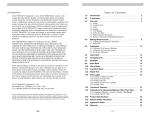
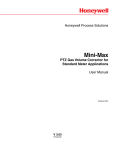
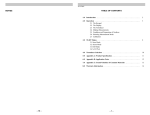
![Roostloggers [Titley] - An Introductory Manual](http://vs1.manualzilla.com/store/data/005649014_1-8c618e497bb2550a491bca85d50a292e-150x150.png)
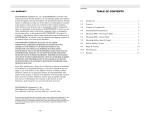

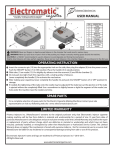

![121290 CR-4000 Controller User Manual [English].pub](http://vs1.manualzilla.com/store/data/005770288_1-ff1b31ed544f6d88740c7f5db9da46b2-150x150.png)

